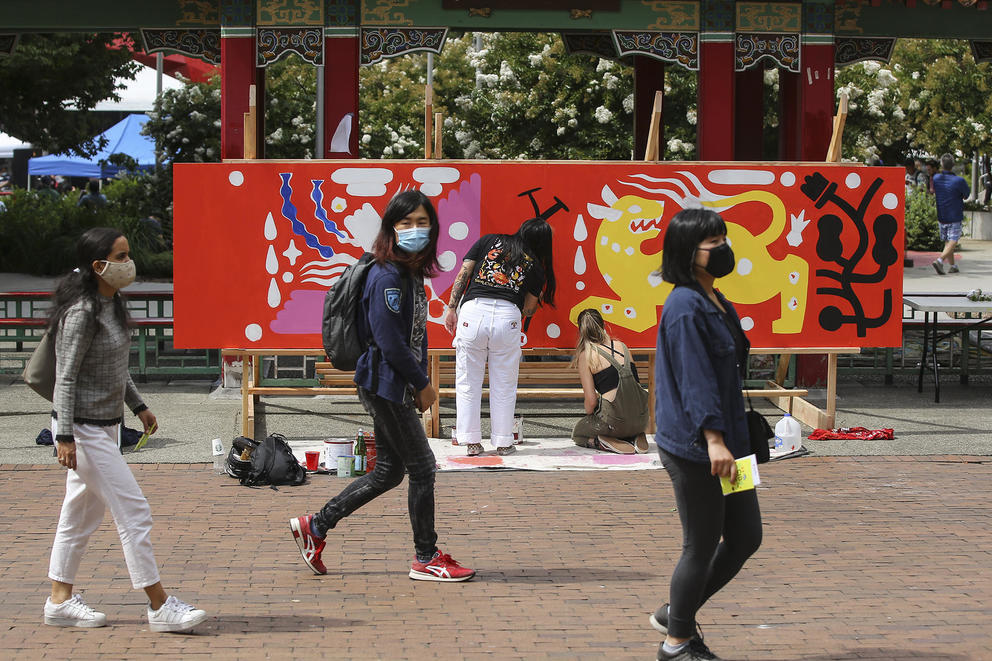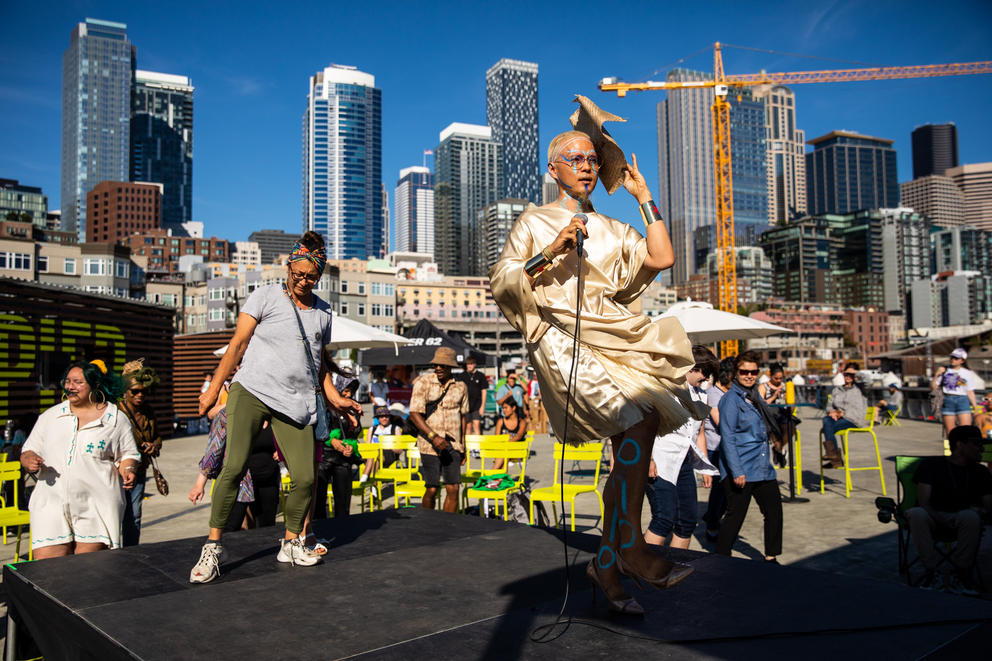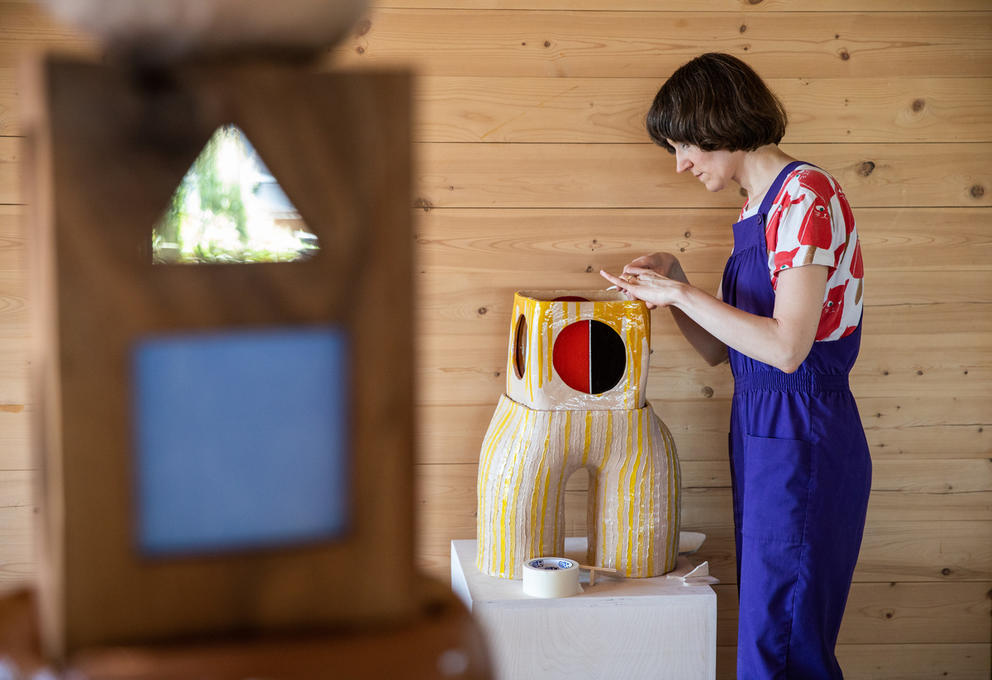Pittard has had to resort to “emergency fundraising” multiple times these past years. When debt started stacking up and rent didn’t seem feasible, Pittard would ask their social media community to pitch in via Venmo, PayPal or Cash App.
Surviving in Seattle as a full-time musician has been difficult for a decade, Pittard says, and they don’t know how much longer they can hold out. They point to musician friends who have gone into tech or real estate to pay the bills, others who have left for the promise of more music gigs in New York or New Orleans. “It’s becoming increasingly a question of: Would I have to leave my profession and my body of work in order to stay here, or would I have to leave in order to continue to pursue my body of work?”
A newly published report says Puget Sound’s arts and culture sector may experience a significant exodus in the next few years, as arts and culture workers — especially younger workers — are considering leaving the sector or the region.
Through a survey conducted this past spring, the Puget Sound Regional Council (an association of local governments and state agencies that helps plan the region’s future growth, transportation and economic development) gathered input from 299 people who work in arts and culture. Some were independent artists, curators and performers, others worked in ticketing or administration of local nonprofits, and many of them had a second job to pay the bills.
This story is part of a series called Reviving Seattle Arts
Roughly a third of respondents indicated they were thinking about leaving the sector, and 4 in 10 respondents said they were considering a change in job or location within the next year. Younger respondents were more likely to be considering leaving the sector: 41% of respondents between the ages of 25 and 34 said they were at least somewhat considering an exit in the next year. Among the main reasons: Wages in the sector are low, and the cost of living in the region is high — and increasing.
“It’s the rent. It’s the cost of living. We can’t survive even WITH stable jobs,” one respondent said in the survey. “I am on the verge of being forced out due to high rents,” another wrote. One simply said: “It’s miserable.”
What would help? Higher wages, more access to affordable housing, affordable benefits and student loan forgiveness, among other things, respondents say.
The survey is part of a larger “Arts and Culture Economic Recovery Strategy” report published today by the Puget Sound Regional Council. It’s the first time the PSRC has come out with a report and strategy focused on the creative economy. The Council felt it was necessary given that the industry was so hard-hit during the pandemic, says Jason Thibedeau, PSRC’s Economic Development Program manager. Another prompt for this first-of-its-kind report: Arts and culture are public goods and economic drivers that attract people to the region and generate revenue in other sectors (like tourism and restaurants).
Local arts and culture are part of what makes this a great place to live, Thibedeau says, but they’re often taken for granted. “If we lose these benefits, these institutions and organizations, our region is not going to be the same place that it was with them,” he says. “It’s going to change the dynamic of who wants to continue to live here or wants to move here.”
To stop the creative brain-drain and improve the region’s creative economy, the report lays out a detailed matrix of solutions and strategies, which range from the macro level (student loan cancellation, affordable housing access) to smaller efforts that could be tried here or scaled up, such as San Francisco’s guaranteed income pilot programs.
It also points to the promise of programs such as Seattle’s public-private Cultural Space Agency, which works to save cultural venues, and the city of Seattle’s Hope Corps program, which puts creatives to work on public art projects, and the nonprofit Seattle Musicians Access to Sustainable Healthcare, which provides access to free and low-cost health services to income-qualified musicians and could be expanded to other cultural workers. Thibedeau describes the strategy document as a “menu” of potential solutions that local governments, philanthropists, businesses and arts organizations could choose from.
“The report is very confirming,” says Manny Cawaling of Inspire Washington, a statewide cultural advocacy organization. “Every aspect of the report was like: ‘Yeah, we heard that too.’ ‘Yes, we heard that too’,” Cawaling says. “Artists, creative people, cultural workers are really struggling to maintain their cultural careers in Washington state. … They struggle with affordability, they can't find housing.”
According to PSRC’s data, the average compensation for someone working in arts and culture in the Puget Sound area in 2021 was $52,400 (including benefits) — about half of the regional average. That same year, a person would have had to make $60,966 to afford rent on a median two-bedroom in the state and $76,240 in the Seattle-Bellevue area only, according to the National Low Income Housing Coalition. According to estimates by HSH.com, a household would have needed to make at least $120,000 a year to be able to buy a home in the Seattle-Tacoma-Bellevue area in 2021.
Pittard, the klezmer musician, said they make between $15,000 and $18,000 a year and can only afford to live in congregate rental housing. “Musicians’ wages on the West Coast are so depressed,” Pittard says. “My friends on the East Coast make triple what I make a gig.”
We can’t entirely blame COVID-19 for the current dire state of the arts, says PSRC’s Thibedeau. For too long, the sector has relied on inequitable funding structures and underpaid workers. Housing affordability and job instability have been a problem for years, as have the sector’s racial inequities. “These have been underlying challenges and issues for the industry for a very, very long time,” Thibedeau says. The pandemic hasn’t helped. “Now things are, like many things, more challenging, more dire.”
With employment in the arts and entertainment sector still down, plus inflation and rising housing costs, the sector may be closer to the edge of the cliff. While there’s no single path, the report does lay out a bridge to the other side.
Building that bridge, according to PSRC, will require a concerted effort by governments, nonprofits, businesses and philanthropists — and a variety of potential building blocks.
The list of the few dozen proposed solutions includes everything from the more straightforward and concrete (adjust noise ordinances so that musicians can play in public spaces later into the evening; alleviate child care expenses for artist-parents; expand Olympia’s and Tacoma’s cultural access programs statewide) to the more aspirational (“engage the larger business community in support of arts and culture,” “develop a sustainable business model for arts and culture”) and inventive (create a regional administrator or task a nonprofit with overseeing benefits for arts and culture workers, like a union).
While the report stresses that higher wages and access to affordable housing and benefits are paramount, it shies away from specifically endorsing or calling out more systemic solutions, like building such housing.
“There was some recognition by our consultants in doing this work that clearly the region's housing challenges are a driving factor in how the arts and culture community can actually operate,” Thibedeau says. “But this [report] is not a strategy to address housing,” he says, adding that PSRC is currently working on a regional housing strategy.
Affordable housing and education would have made a huge difference for fiber and performance artist Cybele León, who saw no other option than to move from Seattle to Bellingham during the pandemic. The “greatest allure of Bellingham was cheap access to aerial and dance training, and family housing” León says, referring to the affordable option of renting a part of her grandparents’ house. León is planning to go back to school for marketing and UX design this fall — another thing she wouldn’t have been able to afford in Seattle, she says. León’s experience is in line with what survey respondents indicated could help: not just affordable housing, but also career support, training and help with student loans.
PSRC’s report also recommends piloting a guaranteed income program for creative workers, pointing to a San Francisco program that paid 130 artists and cultural workers $1,000 monthly stipends, with the money coming from private and public funds (similar programs have also been piloted in New York and St. Paul, as well as Ireland).
While artists and arts workers could potentially benefit from local pilot programs, there are currently no local basic income programs specifically designed for creatives. Nate Omdal, vice president and organizer at the Musicians' Association of Seattle, has been trying to get traction with his idea for a small basic income program for musicians — but getting support from elected officials has proven difficult.
“I can show hundreds of people saying ‘this would be a good thing,’” Omdal says, “but for some reason, that doesn’t count as a request. So I'm struggling internally, trying to figure out: What's the thing that decision makers in this region really do need before they start feeling like something is serious?”
Omdal says the clock is ticking. “I’m terrified for the future of the trade in Seattle,” he says.
The dearth of affordable rehearsal and performance space is another pressing issue the report also aims to address. Among the proposed solutions: Transform vacant and underutilized spaces, like ground floor retail, warehouses, parking lots, green space, malls, libraries and churches, into spaces for art.
That sounds logical, but to do so often requires jumping through lots of hoops, says artist Janet Galore, who with her partner Demi Raven opened the art space The Grocery Studios in a former Beacon Hill corner grocery store in 2016. Because the building was designated “commercial” by the city, the couple had to get a commercial loan, which meant jumping through hoops that “are extra challenging and do not fit the needs of a cultural space,” Galore says. “It requires you to be a bureaucratic contortionist.”
Permitting with the city of Seattle was an additional hurdle. “It feels like city policies, processes, and commercial leasing conventions are optimized only for for-profit commercial developers,” Galore says. “Even for short-term rentals of vacant spaces, I know a number of people who have tried to rent for art exhibition or studio use, and never got a call back from the leasing agent or landlord.”
The report notes that local jurisdictions can support the creation of more art spaces through zoning changes and by making sure art and cultural activities are an allowed “use” of ground floor commercial space.
Though it wasn’t noted in the report, this is something the city of Seattle has done with Seattle Restored. The private-public program builds on legislation that makes it easier to use commercial spaces in certain parts of the city for short-term artistic and other purposes and matches small business owners, artists and entrepreneurs with vacant commercial storefronts. After a first run this past spring and summer, the program will now be expanded to an additional 45 vacant properties throughout the city.
However successful, programs like these don’t solve one of the major issues the report identifies for the arts sector: The current business model — Sisyphean pursuit of meager resources at the expense of making and presenting art — is not just rife with inequities. It’s broken.
What the sector needs, the report specifies, is meaningful state funding. But “Washington State historically provides a low level of support for the arts,” the report goes on to note. “In terms of per capita spending on state arts agencies, Washington is 46th in the nation,” with $0.34 spent per capita in the fiscal year 2022. (Conversely, Washington ranks ninth when it comes to artists as a share of the labor force.)
While the state Legislature appropriated $45 million for grants to businesses and organizations in the arts, heritage and science sectors this year, those dollars represent one-time recovery funding, “not an ongoing financial commitment from the State,” the report says.
But the strategies put forth in this report are just that: strategies. There are no mandates, restrictions or requirements. Still, says Cawaling of Inspire Washington, the report can be helpful in providing a blueprint for a way out. Particularly now, as advocates fear a “funding cliff” while the sector’s recovery lags. The priority, he says, is sustained funding.
“Between now and the end of the year, all major governments — the federal government, county government, city government — are going to approve their budgets for the next year or two,” Cawaling says, adding that Washington state will be discussing its budget from January to May of 2023. “So this is a time when we need to talk about money.”





